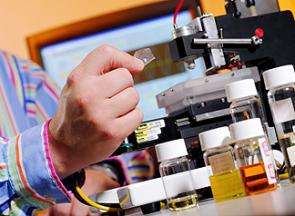Chemical Screening System Helps Evaluate Materials for PEM Fuel Cells

Because of their efficiency and reduced pollution, fuel cells offer a promising alternative to traditional power sources in transportation and other applications. Yet more durable, less expensive materials are needed before these electrochemical devices replace internal combustion engines in vehicles.
Finding those materials will require analyzing potentially billions of possible material combinations. In response, J. Carson Meredith, an associate professor at Georgia Tech’s School of Chemical and Biomolecular Engineering, is developing a new screening system that will enable researchers to evaluate hundreds or thousands of potential materials in a single experiment. Meredith will present details of this combinatorial toolkit on Sept. 10 at the American Chemical Society’s 2006 national meeting in San Francisco.
When it comes to proton exchange membrane (PEM) fuel cells – the type of fuel cell that the automotive industry is focusing on – one of the biggest stumbling blocks is the membrane itself.
Resembling a piece of kitchen plastic wrap, the membrane is sandwiched between two electrodes – an anode and cathode – just as in a battery. As hydrogen gas flows into the fuel cell at the anode side, a platinum catalyst separates the hydrogen into electrons and protons. The membrane’s job is to conduct the positively charged protons through to the cathode side and prevent the negatively charged electrons from passing through. Instead, electrons are conducted through an external circuit to the cathode, creating an electrical charge that can power a vehicle’s electrical motor. Then at the cathode side, the electrons reunite with the protons and oxygen to form water as a byproduct.
“Current membranes on the market are costly because they’re made out of fluorinated materials as opposed to conventional hydrocarbon-based plastics,” Meredith noted. “Durability is another issue. Due to the harsh environment of the fuel cell, the typical lifespan for a PEM is a couple thousand hours. After that, the membranes begin to degrade chemically – and literally fall apart. They develop leaks, and the fuel begins to ‘cross over’ to the oxygen side, causing the electrical current to drop drastically.”
Part of a multi-partner project funded by the U.S. Department of Energy, Meredith is developing a methodology to produce low-cost, thermally stable membranes.
“Our goal is to double the membrane’s durability and cut costs in half,” Meredith said. In addition to Georgia Tech, project partners include the University of Hawaii and three private companies -- Arkema Inc., United Technologies Corp. and Johnson-Matthey.
In contrast to traditional membrane development – a synthesis-intensive process that requires many distinct steps – the partners are taking a “formulation approach.” This involves selecting a number of different polymers, with each one picked for a specific property, and then combining the polymers in one mixing step so the final material retains all of the desired properties.
On that wish list of membrane properties are:
• high conductivity for protons with low conductivity for electrons;
• a very thin material that still maintains its shape and structural integrity;
• the ability to resist acid and hydrolytic degradation; and
• the ability to remain hydrated at high temperatures, yet prevent the fuel (hydrogen or methanol) from passing through.
Besides the unique characteristics of the selected polymers, other factors will affect the final membrane material, such as the ratio of polymers to the mixture, the order of their addition and the speed of stirring.
“Finding the right polymers and parameters is like looking for a needle in a haystack,” Meredith said, noting there are literally billions of choices. “Formulation is a powerful and under-utilized approach to PEM design, but new tools are necessary to discover how to control the formulations.”
That’s where combinatorial methods come into play, integrating computational design, sample libraries, high-throughput screening and informatics.
Although combinatorial methods have been used in drug discovery, Meredith is pioneering their use in fuel-cell technology and other fields. He has developed a technology for depositing large collections of polymers on a single microscopic slide, using property gradients to create thousands of variations in composition, temperature and thickness.
These polymer libraries undergo high-throughput screening, which shows researchers how different samples stack up in terms of mechanical strength, conductivity and water permeability.
“Combinatorial methods allow us to search through possibilities much more efficiently,” Meredith said. “We can run through hundreds of materials in just a couple of hours.”
In contrast to combinatorial methods that Meredith has developed for biomedical applications, the toolkit for fuel-cell membranes requires the capability to screen conductivity and water permeability, and the latter has been one of Meredith’s biggest challenges.
“It sounds simple – expose the material to water vapor and see how much comes through the other side – but it’s subject to a lot of difficulties,” he explained. “For one thing, it’s hard to get all the water out of these membranes so you can measure what goes in.”
Meredith has now developed all the basic components for the fuel-cell combinatorial toolkit and is screening known materials to validate them.
He is quick to note that combinatorial methods are not meant to replace traditional testing where researchers conduct detailed analyses of material. “Our objective is to quickly screen for properties of interest, recognizing that we’re not getting the most accurate measurement possible,” he explained. “We’re substituting speed for accuracy, which means there is a greater uncertainty.”
Yet there’s a big payoff: Combinatorial methods help researchers consider – and identify – more promising materials.
“This enables us to look at a much broader range of possibilities,” Meredith said, explaining that promising polymers can then be analyzed in a more traditional, time-consuming manner. “But if you only use traditional methods, you’re just looking at a few chemistries. These may not be optimal, and you may be overlooking the best material.”

















